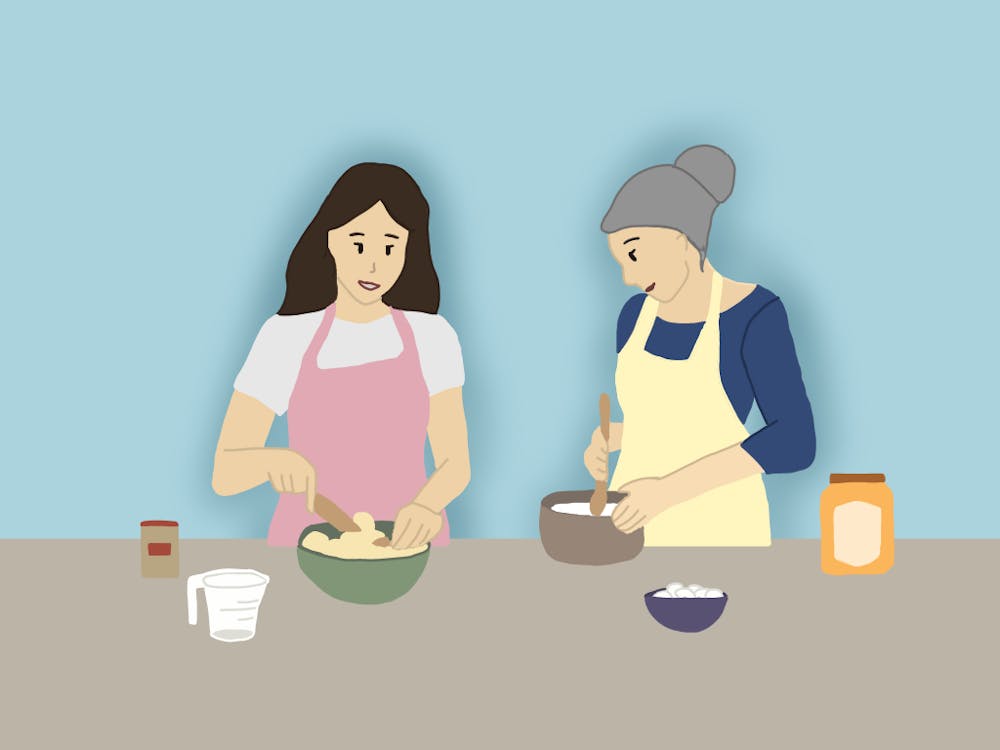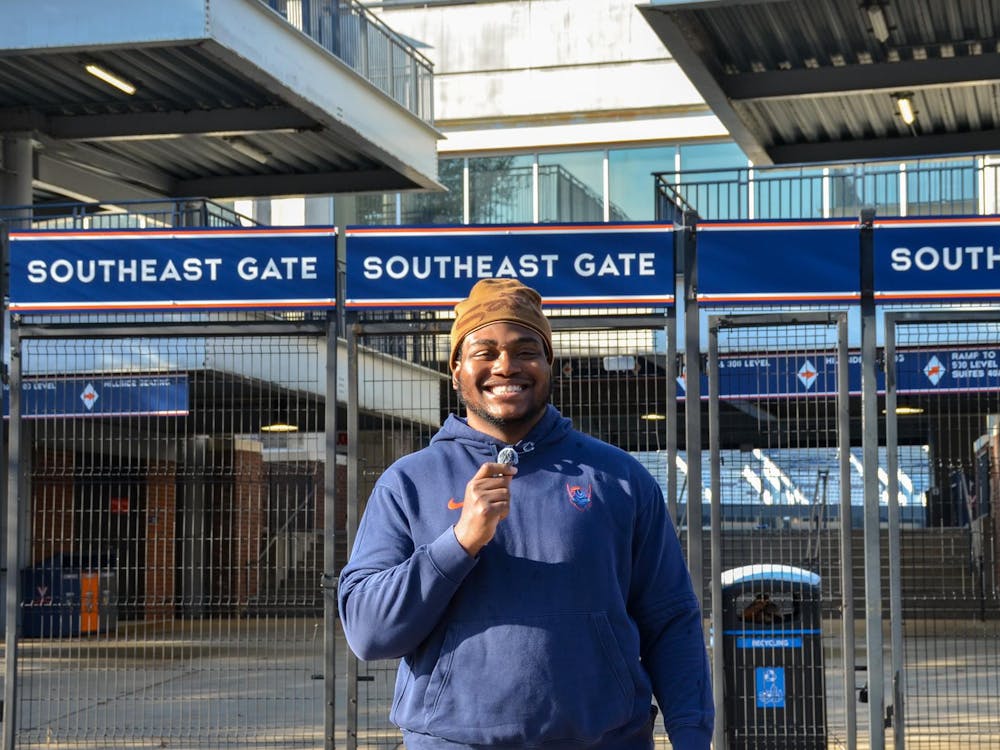It's not the first story they'll tell. It's not a story told very often.
It's the story of black students, leaders and community members and the role they have played in shaping the University's history.
The typical University Guide Service tour focuses on the inspiring architecture, the student leadership and the man who began it all, Mr. Jefferson.
The accounts heard predominately focus on the role of white males in the founding and development of the University, rarely discussing the historical role played by blacks.
Finally, some questions have been answered.
This past weekend, UGS gave a tour entitled "From Slave to Scholar." Guides narrated the tales of many blacks at the University and their struggle for equality.
Erin-Marie Burke, a third-year College student and a member of UGS, came up with the idea for the tour several weeks ago, after hearing Carl Mack speak at the University in celebration of Black History Month.
"He kept saying this one quote," Burke said. "'He who controls history controls the world.' He was telling black students to get involved. He thought one way for black students to do that was to know their history."
As do most historical accounts of the University, this tour also begins with Jefferson.
|
Black History click here |
"No university is more connected to one man or woman than this place," said fourth-year College student Adam Reno, one of the UGS members who gave the "From Slave to Scholar" tour. "But the man who designed this university was a slave owner. In some ways, Jefferson believed in the equality of all men, but in other ways, he was scientifically racist."
According to Reno, before Jefferson took the presidency, he spoke out frequently against the act of slavery, believing the institution to be morally wrong.
But once he was elected as president, Jefferson quickly turned silent on the subject.
Following his presidency, Jefferson became ironically the second largest slave owner in all of Albemarle County.
Frequently, students around Grounds discuss the vast array of beautifully designed buildings constructed by Jefferson.
"But Jefferson didn't build U.Va.," Reno said. "He designed it. Black people built these [Lawn] rooms 150 years ago in forced servitude, and now they live in them."
Today blacks are living as true residents of the Academical Village, quite a switch from the quartered slaves who once lived in basement rooms beneath the Lawn Pavilions years ago.
One of the greatest honors given to a single student from the fourth-year class is to be chosen to receive free residency in the "good-guy" room on the Lawn.
This year, fourth-year Engineering student Bryan Edmonds received that honor for his selfless commitment to the community.
Edmonds is only the second black student to live in the "good-guy" room.
"It has been an awesome honor to represent a man such as Augustus Blagden," for whom the "good guy" room is named, Edmonds said. "But it has been even more rewarding to serve as a positive example of what U.Va.'s African-American community produces."
Edmonds acknowledges that one of the biggest challenges he faces as a leader is being overworked.
"But it is important to be mindful of the many aspects of the community that we are called to represent, understanding that some black leaders will be the only face that many community members see or hear from," Edmonds said.
As the tour continued, guests learned that not only was Jefferson a slave owner, but so too were at least three of the University's original professors - Charles Bonnycastle, Robley Dunglison and John Patton Emmet, all of whom lived on the Lawn when the University opened its doors to students in 1825.
At that time, students too were permitted to quarter slaves, although they were forced to keep them with residents in the Charlottesville community.
It took almost 100 years for the role of blacks to fully transition from oppressed slave to scholar at the University, and by no means was it a painless journey.
In 1953, Walter Ridley made history as the first black to graduate from the University. He earned a doctorate degree.
Six years later the first black student earned an undergraduate degree.
Throughout the civil rights movement, University students, black and white alike, began protesting and calling for greater student diversification.
University President John T. Casteen III, who was the admissions dean from 1975 to 1982, played an integral role in the diversification of the student population, along with Ernest Ern, the admissions dean in the early '70s.
"President Hereford told me when I began this job that we needed to succeed in recruiting and educating a more representative student body, with special concern for African-American students," Casteen said.
Casteen explained that the recruitment strategy was pretty basic from its inception.
"We sought out school counselors, clergy, community leaders and others to help us identify talent," Casteen said. "We went to family homes, church meetings, NAACP and similar meetings, YWCAs and college fairs to advise students to take the hard courses early and to stick with them."
The admissions office aimed for the enrollment of about 50 additional black students each year, and today, black students comprise almost 10 percent of the student population.
Throughout the community, black students frequently are making a huge difference in the quality of education, character and morale of the University.
"I see a much more racially diverse Honor Committee than there's ever been and a peer advisor program that helps to establish first-year African-American students as soon as they arrive," Edmonds said. "I see the Office of African-American Affairs that is the backbone for growth in the black community and more socially aware black leaders that are making a difference in the black community and in the University community at large."
Edmonds accredits the success of black students at the University to "the resolve and persistence that is very much a part of the African-American spirit and nature."
For a fitting end to the tour, which began at the steps of the Rotunda, the group finished in front of the OAAA on Dawson's Row.
At the end of the tour, fourth year Engineering student Angela Nash expressed how beneficial the tour was for her. Nash said she felt the tour helped in terms of her growth and understanding of the black community at the University.
"I'm just overwhelmed right now," Nash said. "I didn't expect this."
Nash explained that as a fourth year, she has tried to make it a point to learn all that she can about her heritage and its place at the University.
"But when you get to the end of the journey, you look back and realize you need to fill in some spaces," she said. "And this one filled in so much. Everything just connected full circle for me."
In the future, UGS plans to continue giving the tour begun by Burke. Next year, UGS hopes to give the tour every Saturday in February, during Black History Month.
Burke said she believes it is essential for black students at the University to continue building on with the work done by those leaders who came before them.
"I think it's our duty to not let all of their work be in vain," Burke said. "For us to be here and not appreciate it, I think that's the greatest loss of all. We need to let these people know that we are thankful for that they did"






